The greatest feasts in Art
by Jason Farago
Leonardo da Vinci, The Last Supper, late 1490s
 Depictions
of Jesus' final meal with his 12 apostles in Jerusalem have been a
popular artistic subject since the days of early Christianity, but
Leonardo's is the most famous -despite severe damage and clumsy
restorations that have left it a shade of its former self. Christ,
sitting dead centre at the composition's vanishing point, proclaims that
one of his apostles will betray him; Judas, fourth from the left, leans
back and reaches incriminatingly for a piece of bread. There's no
paschal lamb to be seen on the apostles' feast, but rather grilled eel
and orange slices, off to the right. (Leonardo da Vinci) Depictions
of Jesus' final meal with his 12 apostles in Jerusalem have been a
popular artistic subject since the days of early Christianity, but
Leonardo's is the most famous -despite severe damage and clumsy
restorations that have left it a shade of its former self. Christ,
sitting dead centre at the composition's vanishing point, proclaims that
one of his apostles will betray him; Judas, fourth from the left, leans
back and reaches incriminatingly for a piece of bread. There's no
paschal lamb to be seen on the apostles' feast, but rather grilled eel
and orange slices, off to the right. (Leonardo da Vinci)
 Paolo
Veronese, The Wedding at Cana, 1563 Paolo
Veronese, The Wedding at Cana, 1563
This massive feast scene has the singular misfortune of hanging
across from the Mona Lisa in the Louvre's Italian wing, thus making it
one of the most ignored masterpieces of all of Western art. The
mega-wedding, at which Christ has just turned water into wine, has been
transposed from Cana to contemporary Venice. The finely dressed guests
seem to be on the dessert course, but note that none of them is actually
eating. While a genre scene might depict lower-class wedding-goers
consuming food and drink, here the feast is a public pageant, a showcase
for wealth and power. (Paolo Veronese)
Diego Velázquez, Triumph of Bacchus, 1628
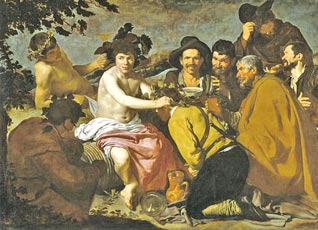 Nicknamed
'Los Borrachos' -the drunks -this important early work by Velázquez
features the god of wine, pale-skinned and crowned with ivy, alongside
leathery-faced workers who are wearing much more sober and Spanish brown
cloaks. It's one of his few mythological scenes, and it departs from
earlier depictions of Bacchic revelry, which usually featured prancing
nymphs and rolling hillsides. Velázquez's move to a more naturalistic
style, more common to the genre scenes known as bodegones, suggests he
sympathised with the desire of these men to let loose after the day was
done. (Velázquez) Nicknamed
'Los Borrachos' -the drunks -this important early work by Velázquez
features the god of wine, pale-skinned and crowned with ivy, alongside
leathery-faced workers who are wearing much more sober and Spanish brown
cloaks. It's one of his few mythological scenes, and it departs from
earlier depictions of Bacchic revelry, which usually featured prancing
nymphs and rolling hillsides. Velázquez's move to a more naturalistic
style, more common to the genre scenes known as bodegones, suggests he
sympathised with the desire of these men to let loose after the day was
done. (Velázquez)
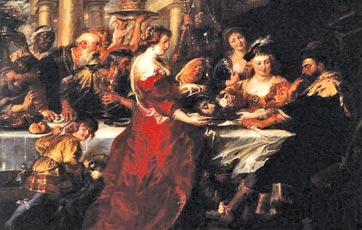 Peter
Paul Rubens, The Feast of Herod, 1635-38 Peter
Paul Rubens, The Feast of Herod, 1635-38
The ultimate party foul: you lift up the lid on the serving tray, and
there, staring back at you, is the head of John the Baptist. Rubens's
grand painting, stylish and macabre by turns, shows the moment when
Salome, having danced for her stepfather Herod, wins her prize of the
decapitated saint - which is presented as just another course at this
feast, along with lobster and game birds. Herodias, Salome's mother,
pokes at John's tongue with a fork, while her husband's eyes bulge in
horror. (Peter Paul Rubens)
John Martin, Belshazzar's Feast, c 1821
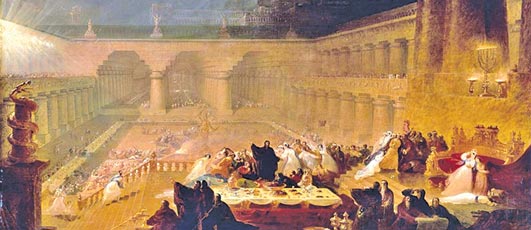 Martin
was one of the strangest painters of 19th-Century England, given to
apocalyptic visions that often tipped into kitsch. Here he depicts a
dizzying scene from the Book of Daniel, in which the titular king of
Babylon gets the bad news, glowing on the wall at left, that "thou art
weighed in the balance and found wanting." The feast in the foreground
is overshadowed by Martin's comically grand fantasy of Babylonian
architecture, with columns extending out to infinity, and the terrible,
lightning-cracked sky above. (John Martin) Martin
was one of the strangest painters of 19th-Century England, given to
apocalyptic visions that often tipped into kitsch. Here he depicts a
dizzying scene from the Book of Daniel, in which the titular king of
Babylon gets the bad news, glowing on the wall at left, that "thou art
weighed in the balance and found wanting." The feast in the foreground
is overshadowed by Martin's comically grand fantasy of Babylonian
architecture, with columns extending out to infinity, and the terrible,
lightning-cracked sky above. (John Martin)
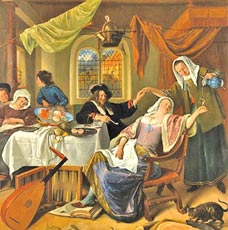 Jan
Steen, The Dissolute Household, 1663-4 Jan
Steen, The Dissolute Household, 1663-4
While feast scenes in the High Renaissance depicted gods or nobles,
Dutch artists in the 17th Century turned to domestic scenes, sometimes
with a moralising gaze. Steen's revellers indulge in just about every
sin imaginable: the man in black is trying to seduce the serving maid,
while the woman in the foreground is so busy getting her drink on that
she doesn't notice she's trampling a bible underfoot. As for the large
ham that served as the centre of this feast, it's been abandoned on the
floor, ready to be eaten by the family cat. (Jan Steen)
James Ensor, The Banquet of the Starved, 1915
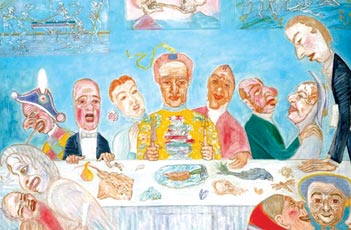 After
the German army occupied Belgium at the start of World War One, Ensor
painted this bitter parody of the Last Supper. Instead of a sumptuous
paschal feast, the diners are sitting down to a table with just two raw
carrots, an onion, and insects, in evocation of the horrible famine that
overtook Belgium in the year Ensor completed the work. The diners are
grabbing each other in poses that could be sexual or violent or both,
while in the background hang three paintings-in-the-painting: tableaux
of skeletons, dancing or fighting. (James Ensor) After
the German army occupied Belgium at the start of World War One, Ensor
painted this bitter parody of the Last Supper. Instead of a sumptuous
paschal feast, the diners are sitting down to a table with just two raw
carrots, an onion, and insects, in evocation of the horrible famine that
overtook Belgium in the year Ensor completed the work. The diners are
grabbing each other in poses that could be sexual or violent or both,
while in the background hang three paintings-in-the-painting: tableaux
of skeletons, dancing or fighting. (James Ensor)
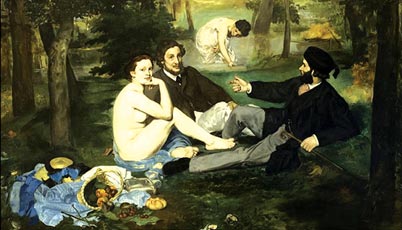 Giovanni
Bellini, The Feast of the Gods, 1514 Giovanni
Bellini, The Feast of the Gods, 1514
The divine banquet was a frequent theme of Italian painting in the
16th Century, and in fact many Renaissance artists would stage their own
banquets with Olympian costumes and lavish eats. (The painter Andrea del
Sarto once designed a church made of sausages and parmesan.) Bellini's
final major work - made with assistance from a young Titian, his student
- is a masterpiece of this mythological genre: the fertility god Priapus
is putting the moves on a nymph on right, while Jupiter and the other
divinities are drinking wine. An innovation: Chinese blue-and-white
porcelain, newly imported to Europe. (Giovanni Bellini)
Édouard Manet, Le Déjeuner sur l'herbe, 1862
 The
greatest painting in the history of Western art, rejected by the Paris
Salon and scorned by Napoleon III himself, broke all the rules of
perspective, illusionism, and iconography (why are the men in modern
dress, why is the woman naked, why aren't they looking at one another?).
But Manet's up-to-the-minute pastoral scene is not much of a picnic:
just some fruit and a brioche, tumbling out of a basket and onto the
grass and the nude woman's discarded clothes. What's significant is not
the fanciness of the picnic, but its newness - no more mythology, no
more moralising, just the blunt facts of modern life. (Edouard Manet) The
greatest painting in the history of Western art, rejected by the Paris
Salon and scorned by Napoleon III himself, broke all the rules of
perspective, illusionism, and iconography (why are the men in modern
dress, why is the woman naked, why aren't they looking at one another?).
But Manet's up-to-the-minute pastoral scene is not much of a picnic:
just some fruit and a brioche, tumbling out of a basket and onto the
grass and the nude woman's discarded clothes. What's significant is not
the fanciness of the picnic, but its newness - no more mythology, no
more moralising, just the blunt facts of modern life. (Edouard Manet)
 Judy
Chicago, The Dinner Party, 1974-79 Judy
Chicago, The Dinner Party, 1974-79
The iconic work of American feminist art is the ultimate feast: a
banquet table set for more than three dozen great women, from Sappho and
Hatshepsut to Emily Dickinson and Virginia Woolf. The focus isn't the
food but the covers: each guest has a unique place setting, most of
which feature plates in the form of a certain part of a woman's anatomy.
Chicago completed the work with the help of 400 volunteers, and while
most feasts put the guest of honour in the centre, this one is in the
shape of an equilateral triangle, with uniform billing for everyone.
(Stan Honda/AFP/Getty Images)
-BBC Culture
|

